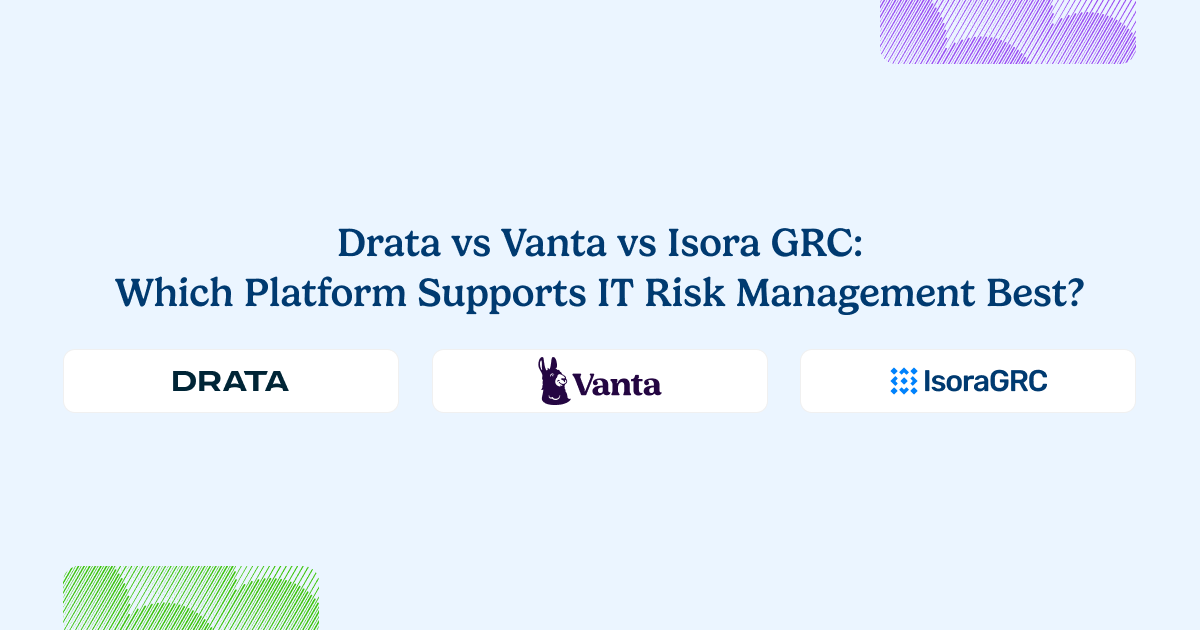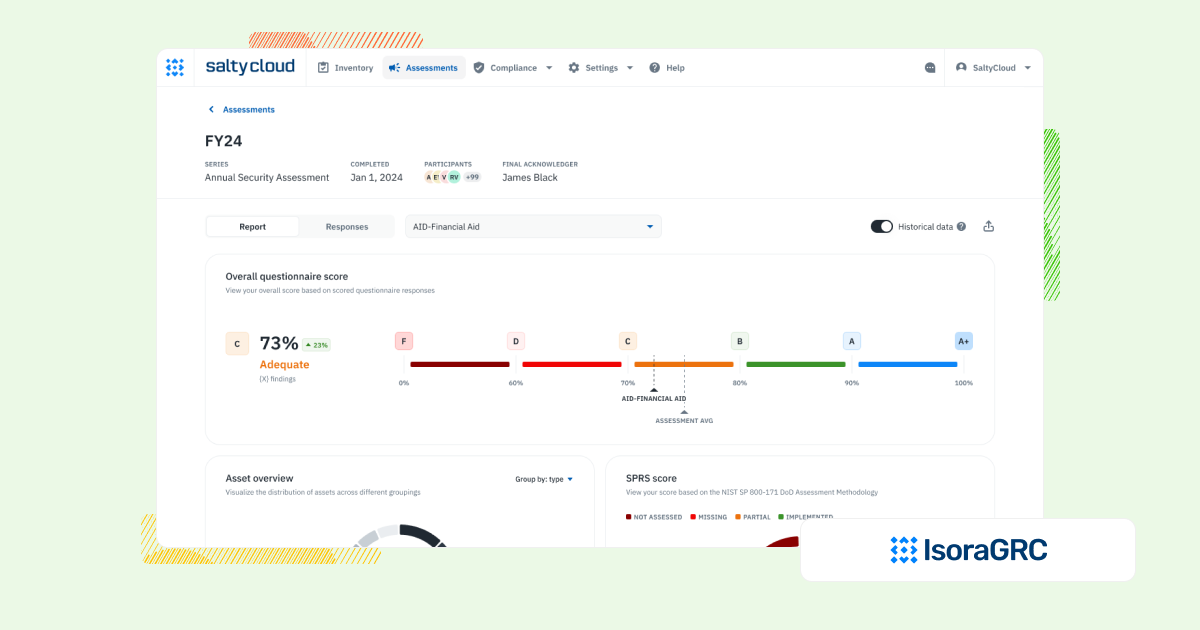
Every security team needs a practical, scalable way to manage IT risk—not just prepare for audits.
Platforms like Drata and Vanta focus on compliance automation, helping teams get through SOC 2, ISO 27001, and similar frameworks quickly.
These tools automate audit prep, but don’t support the deeper workflows required for ongoing IT risk management across assets, vendors, and business units.
Isora GRC offers a more specialized approach. It’s purpose-built for security teams who need to run assessments, manage inventories, and track risks—without being limited to audit-driven workflows.
Let’s take a closer look.
Choosing the Right Platform for IT Risk Management
Drata and Vanta work well for early-stage compliance, but they weren’t built for the full lifecycle of IT risk. They don’t offer robust risk management capabilities or scalable ways to assess teams and vendors over time.
Isora GRC bridges that gap. It’s a complete platform for managing risk across your organization—with flexible assessments, inventory tracking, exception handling, and centralized risk reporting. It complements audit tools, but gives you the structure and control you need to manage real risk.
The Workflow That Matters: Managing IT Risks and Compliance
Security isn’t static, and neither is risk. Teams need to collect information continuously—from systems, departments, and vendors—and turn it into insight they can act on. That means sending assessments, collecting responses, maintaining inventories, and documenting exceptions and emerging risks.
Platforms like Drata and Vanta help gather evidence for audits, but they don’t support this full workflow. Isora GRC makes it easy to run recurring assessments, update inventories, and keep a living risk register that reflects your actual posture—not just a compliance snapshot.
How Each Platform Supports IT Risk Management Workflows
| Workflow Area | Drata | Vanta | Isora GRC |
| Assessment Management | Drata supports continuous compliance with automated assessments. Some users say the system feels too strict. Customization is limited, which may cause problems for companies with complex needs. | Vanta automates SOC 2, ISO 27001, and more. Still, some say it’s too focused on standard setups. Companies with special needs might feel boxed in. | Centralized, intuitive assessment dashboard across business units, vendors, and assets. Built specifically for security teams. |
| Questionnaire Delivery & Completion | Drata includes vendor questionnaires. However, some users want more advanced features. Dynamic workflows, for example, could make assessments more interactive. | Vanta supports compliance questionnaires. Advanced options feel limited, especially for large or custom forms. | Customizable and prebuilt questionnaires for frameworks like NIST, ISO, GLBA, HIPAA, and more. Designed for internal and external collaboration. |
| Inventory Tracking | Drata focuses on compliance, not asset tracking. Companies with lots of assets may need deeper tracking tools. | Vanta handles compliance better than asset tracking. Teams needing full inventory tools might feel shortchanged. | Centralized tracking of assets, vendors, and organizational units with integration support for existing data sources. |
| Risk Register & Exception Management | Risk tools exist in Drata, but many users find them too basic. Larger teams may need stronger options for risk and exception handling. | Risk tools exist but feel basic. Exception handling lacks depth. Big teams with complex systems may face roadblocks. | Flexible, collaborative risk register with scoring, status, evidence, and ownership tied directly to assessments. Exception management is built-in and intuitive—no extra modules or configuration required. |
| Scoring, Reporting & Risk Visualization | Drata creates automated reports and dashboards. Some users say the reports lack detail and flexibility. Risk visuals feel limited for those needing deeper insights. | Dashboards give a quick view, but detailed reports fall short. Risk visuals feel simple, which may limit deep reviews. | Automated scorecards, risk maps, and executive-friendly reports with actionable insights—no manual config required. |
| Collaboration & User Experience | Drata has a clean and simple interface. Still, collaboration tools feel shallow. Big teams may struggle with cross-department workflows. | Vanta looks easy to use. Still, some say team collaboration feels thin. Cross-team compliance work may slow down. | WCAG-compliant, award-nominated interface with built-in commenting, team workflows, and fast onboarding. |
| Implementation & Setup | Setup looks simple at first. But some teams report long onboarding times. Complex setups often need expert help, which may be tough for smaller companies. | Vanta works well out of the box. But teams with unique setups may face delays. Custom workflows often need more time. | No-code setup in days or weeks. Minimal IT lift required. Designed to go live quickly across teams and vendors. |
What Sets Isora GRC Apart?

Isora GRC was purpose-built for information security teams—designed to support the real workflows behind risk and compliance, not just generate reports. While legacy GRC platforms require months of configuration and rigid processes, Isora takes a modern, scalable approach:
- Purpose-built for security and third-party risk teams
- No extra modules or cross-department bloat—just the workflows that matter.
- Easy for anyone to use
- Clean UI, no complex training, and built to drive adoption across the org.
- Streamlined for action, not just documentation
- Assessments, questionnaires, inventories, risk tracking, and reporting—all in one place.
- Fast, no-code implementation
- Go live in weeks, not quarters, with minimal IT lift.
- Scales with your program
- Whether you’re running a lean risk function or supporting a large institution, Isora grows with you—without getting in the way.
Who Each Platform Is Best For
| Platform | Who It’s For |
| Drata | Startups rushing to get SOC 2 done. Quick wins, but not built for full-risk programs. |
| Vanta | Fast-moving teams trying to check off audit boxes. Good for early compliance, not much else. |
| Isora GRC | Security teams that need a scalable, usable IT risk management program across their organization. |
What Our Customers Say About Isora GRC
Security teams at top institutions are using Isora GRC to replace legacy tools and manual processes with intuitive workflows and actionable insight.
“Moving from manual processes to using Isora was a breath of fresh air. What used to take months is now automated, reliable, and defensible. Isora saves us significant time while delivering accurate insights that improve decision-making.”
Jessica Sandy, IT GRC Manager, The University of Chicago
“Isora has been essential in helping us meet our University of California cybersecurity requirements across a decentralized campus. Automating assessment data collection and reporting has given us clear visibility into unit-level risks, enabling us to prioritize resources effectively and address gaps with confidence.”
Allison Henry, CISO, The University of California, Berkeley
FAQs
What’s the difference between Drata, Vanta, and Isora GRC?
Drata and Vanta automate evidence collection for frameworks like SOC 2, ISO 27001, and HIPAA. Isora GRC supports broader IT and vendor risk management workflows—including internal assessments, asset inventories, risk registers, and exception tracking—not just audit prep.
Are Drata and Vanta considered GRC platforms?
Not entirely. They are audit-first tools focused on compliance automation. While they touch on some GRC elements, they don’t offer the workflow flexibility or cross-organizational support of a full IT risk management platform like Isora GRC.
Does Isora GRC replace platforms like Drata or Vanta?
For organizations focused on broader IT and vendor risk, yes. Isora GRC handles risk as a continuous, collaborative process—across assessments, exceptions, and risk tracking—rather than just automating audits.
Which platform is better for managing IT and vendor risk across the organization?
Isora GRC is built for that exact purpose. It enables teams to assess internal and third-party risk, manage inventories, and engage stakeholders across departments. Drata and Vanta are best suited for fast-moving audit preparation.
Can Isora GRC be used alongside Drata or Vanta?
Yes. Many teams use Drata or Vanta for audit automation and Isora GRC for ongoing risk management workflows. Isora can also serve as the primary risk platform when teams want deeper flexibility and broader coverage.
What should I look for in a platform to manage IT risk beyond compliance?
Look for assessment management, risk tracking, exception handling, and inventory support. Isora GRC delivers these capabilities in a platform designed for security teams—not just compliance deadlines.



















 Other Relevant Content
Other Relevant Content